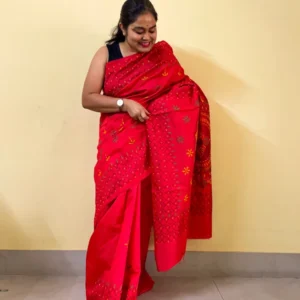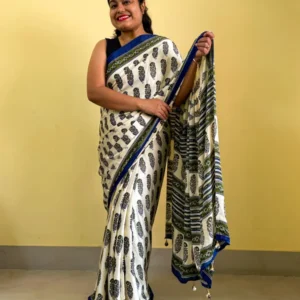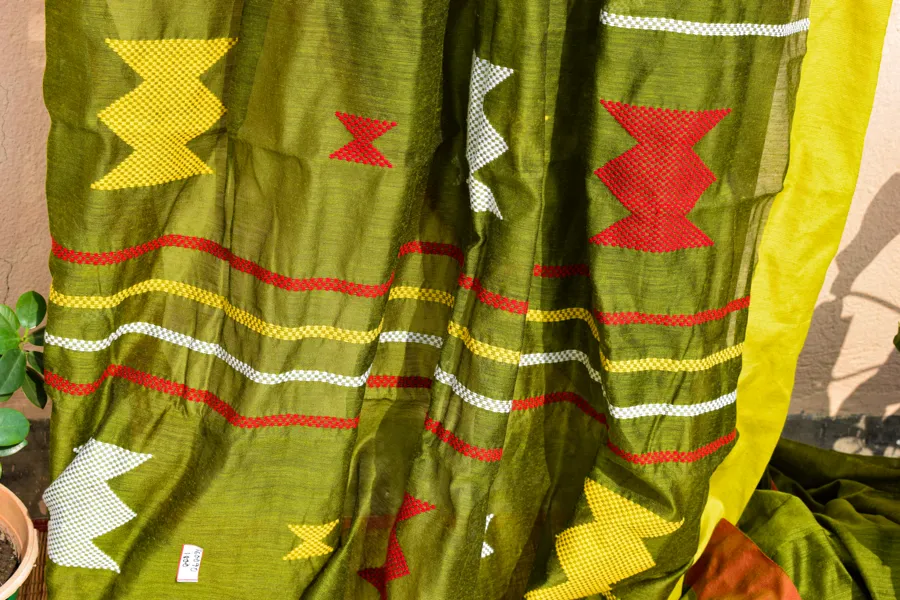Kasuti is a traditional embroidery form. It is practised by the Lambani women of Dhanward district, Karnataka. The embroidery is done in other regions like Bijapur, Belgaum and Hubli as well.
This art form has been unique from historical times. In about the 17th Century, it was supposed to be necessary for the women courtiers of the Royal state of Mysore to learn and know this art form.
The word Kashida in Hindi means embroidery and Kasuti is its equivalent in Kannada. Kasuti comprises two words, Kai meaning Hands and Suti meaning Cotton Threads.
About the Art and Its Usage of Kasuti
The Products on which Kasuti embroidery can be seen
Kasuti embroidery is geometric and is done by the women in their homes and restricted on cholis, sarees and kid’s garments. The embroidery, thus, was limited to majorly these five products like (i) Seragu (pallu of the saree), (ii) Kunchi (bonnet and cape combined), (iii) Lenga (skirt), (iv) Kusuba (bodice) and (v) Kulai (bonnet).
The nine yards Ilkal saree was prefered for this embroidery and one special kind was integral to wedding customs. In olden times, the bride was gifted with a black Ilkal saree with a red border with Kasuti work done on it, known as Kali Chandrakala. She needed to possess one of these.
Earlier, this embroidery was done on Ilkal sarees and Khann fabric used as blouse pieces. Today it is done on a variety of fabrics and products like curtains, cushion covers and many such household items made of handwoven fabric.
Motifs
The empires in the South had a very rich culture. They built magnificent shrines and other architecture embracing art, culture and learning. The women observed and got inspired by this architecture and embroidered these designs on the garments. The embroidered motifs like the gopurams, chariots, palanquins, flowers, birds and animals on the borders and pallus of sarees. The lotus flower, a squirrel, birds like a parrot, peacock and swan were the commonly used motifs. Animals like the sacred bull, the elephant and the deer were used as motifs. Some other motifs used were cradle, cattle, flower pot and tulsi katte (enclosure for the tulsi plant). Motifs of horse, lion and tiger are rarely used, but dog and cat motifs are never used.
Stitches
There are four stitches that are majorly used in Kasuti embroidery.
(i) Gavanti: It means knot in Kannada. It is the most commonly used double running stitch and is worked in vertical, horizontal and diagonal directions. The designs appear to be identical on both sides of the fabric. The lines or motifs need to be completed on the return journey by filling the blank portions of the running stitch.
(ii) Murgi: It is the zigzag running stitch that appears like the steps of a ladder. It is similar to Gavanti, both are neat and the design on the back and front sides of the cloth is identical. These stitches are regular and uniform in length, so the distance between the stitches remain the same.
(iii) Menthi: It means fenugreek seed in Kannada. This stitch generally had a heavy appearance as a large amount of thread was required to do it. Hence, usage of this stitch was avoided. It is the ordinary cross stitch and is usually used for filling in Negi stitch or the background area of the design. Nowadays, many of the Kasuti workers are using this cross stitch but it is not very closely worked as it used to be earlier.
(iv) Negi: The word Ney means to weave in Kannada and this stitch resembles the weaver’s patterns and thus, the wrong and right sides of the design are not identical. It is an ordinary stitch known as the darning stitch or weaving stitch. This stitch is used for larger designs by varying the stitch (long and short straight lines) according to the surface that is to be covered with the thread.
Thread
Earlier, the thread drawn from the cloth itself was used to do the embroidery, now they use silk threads sourced from Mysore. The usage of silk thread ensures that the surface looks flat even after the embroidery.
Nowadays, even mercerized cotton thread such as Anchor or Kohinoor thread or pure silk thread that are strong and have colour fastness is used for Kasuti embroidery and a single strand is mostly used. Before the beginning of the work or at the end of the work, they never put a knot to the end of the thread.
The needle used to do Kasuti embroidery must be made of steel.
Colours
- The most used colours for Kasuti are red, orange, purple and green. The most used combination of these four colours is either purple, red and orange or green, red and orange.
- White is used predominantly on a black and dark background.
- Because of the contrasting harmony, blue and yellow are rarely used as a combination.
- Lemon yellow, pale green and bright pink colours are hardly used.
Kasuti embroidery shows a true artistic sense when multi-coloured with a harmonious blending and is one of its important features.
What is the Usage of Kasuti?
- This embroidery is considered a traditional art and is passed on from generation to generation. A mother would train her daughter in this art from a very young age.
- Traditionally, it was a custom to gift Kasuti embroidered garments to relatives when a new baby is born in the family.
- The Kali Chandrakala saree (black Ilkal saree with red border) has Kasuti embroidery on it and a bride must possess it.
- This embroidery was mostly done on Ilkal sarees and Khann blouse pieces.
- Nowadays, this embroidery is done on products other than sarees as well. It can be seen on salwar kameez and dress materials made of not just cotton material but of silk and nylon as well. Kurtis embellished with Kasuti work have also gained popularity.
- The embroidery is done on several home decor as well. Products ranging from cushion covers, curtains, furniture covers and many such items are available with this embroidery work on them.
- The craft has gained popularity in foreign countries as well due to its intricate design, exquisite handwork and harmonious colour combinations and the machines have not been able to replicate them yet.
How to Maintain Kasuti?
When taking care of Kasuti embroidery products, regular wash in the machine or dry cleaning is enough. As far as these sarees are concerned, no heavy maintenance is required, one can simply soak them in a hot water bucket.
What is the Current Scenario of Kasuti?
- Some places where Kasuti embroidery is still done are Dharwar, Hubli, Kalghatgi, Gadag and Mundargi.
- This embroidery is done mostly by women who work in cooperative societies. Regional Institute of Handicrafts, Janata Shikshana Samiti, Bhagini Samaj have set up organizations to help these women earn a living.
- Over 500 women are doing this work and they are between the age group of 18 to 55 years.
Follow through Wikipedia page.

 Red Art Silk Saree with Floral Multicolour Kantha Embroideries
Red Art Silk Saree with Floral Multicolour Kantha Embroideries  Off White Semi Modal Silk Saree with Ajrakh Border
Off White Semi Modal Silk Saree with Ajrakh Border 